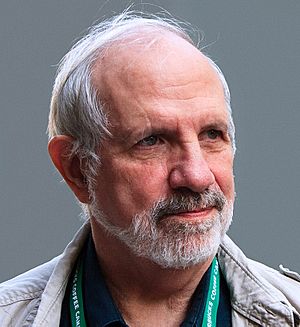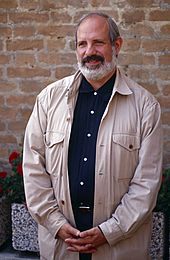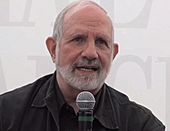Brian De Palma facts for kids
Quick facts for kids
Brian De Palma
|
|
|---|---|

De Palma in 2009
|
|
| Born |
Brian Russell De Palma
September 11, 1940 Newark, New Jersey, U.S.
|
| Alma mater | |
| Occupation |
|
| Years active | 1960–present |
| Spouse(s) |
|
| Children | 2 |
Brian Russell De Palma (born September 11, 1940) is an American film director and screenwriter. He has worked in movies for over 50 years. He is famous for his films in the suspense, crime, and psychological thriller styles. De Palma was an important part of the "New Hollywood" group of filmmakers. This group changed how movies were made in the 1960s and 1970s.
His movie Carrie (1976), based on a book by Stephen King, made him a well-known young director. He had big successes with Dressed to Kill (1980), The Untouchables (1987), and Mission: Impossible (1996). He also made popular movies that became "cult classics" like Greetings (1968), Hi, Mom! (1970), Sisters (1972), Phantom of the Paradise (1974), and The Fury (1978).
As a young director, De Palma wanted to be like the famous French director Jean-Luc Godard. His films often refer to other movies. For example, he honored Alfred Hitchcock in Obsession (1976) and Body Double (1984). His movie Blow Out (1981) was inspired by Blowup (1966) by Michelangelo Antonioni. Scarface (1983), which was a remake of a 1932 film, was dedicated to its original director, Howard Hawks. Some people have criticized his movies for being too violent. However, many film critics, like Roger Ebert, have praised his work. In 2015, a documentary called De Palma was made about his career.
Contents
Early Life and Education
Brian De Palma was born on September 11, 1940, in Newark, New Jersey. He was the youngest of three boys. His parents were Vivienne and Anthony F. DePalma. His father was a surgeon. Brian grew up in Philadelphia, Pennsylvania, and New Hampshire. He went to different schools, including Quaker schools. He graduated from Friends' Central School.
When he was in high school, Brian enjoyed building computers. He even won a science fair prize for a project about computers. He first went to Columbia University to study physics. But he became very interested in filmmaking after watching movies like Citizen Kane (1941) and Vertigo (1958).
After getting his first degree in 1962, De Palma went to Sarah Lawrence College. He studied in their theater department and earned a master's degree in 1964. At college, he was influenced by many artists and directors. These influences helped shape his unique filmmaking style.
Career
Early Films and Rising Fame (1963–1976)
Brian De Palma worked with a young actor named Robert De Niro on an early film called The Wedding Party. This movie was filmed in 1963 but was not released until 1969. By then, De Palma was becoming known in the Greenwich Village filmmaking scene in New York. The film used old silent movie techniques and quick cuts.
During the 1960s, De Palma also made documentaries. One notable film was The Responsive Eye (1966). It was about an art exhibit at MoMA. He also made Dionysus in '69 (1969). This film recorded a play and was famous for using a split-screen technique. This allowed viewers to see two different things happening at the same time.
His important movies from this time include Greetings (1968) and Hi, Mom! (1970). Both films starred Robert De Niro. Greetings won an award at the 19th Berlin International Film Festival. Another film from this period was the comedy Murder a la Mod (1968). These early movies showed De Palma's experimental style.
In 1970, De Palma moved to Hollywood. He directed Get to Know Your Rabbit (1972). After that, he made several smaller films. These included the horror movie Sisters (1972), the musical Phantom of the Paradise (1974), and Obsession (1976). Obsession was inspired by Alfred Hitchcock's Vertigo.
Big Success (1976–1979)
In November 1976, De Palma released Carrie. This movie was based on a book by Stephen King. It was a smaller project at first. But Carrie became De Palma's first big hit at the box office. The movie helped Sissy Spacek and Piper Laurie get Oscar nominations for their acting.
Many actors from Carrie had also been considered for George Lucas's Star Wars. De Palma's film used special visual techniques like split-screen and slow motion. These techniques helped tell the story without needing a lot of talking.
The success of Carrie allowed De Palma to make more personal films. He had always wanted to adapt a novel called The Demolished Man. This led to his 1978 science fiction thriller, The Fury. It starred Kirk Douglas and Amy Irving. The film was praised by some critics, including Pauline Kael.
Becoming a Well-Known Director (1980–1996)
The 1980s were a big time for De Palma. He directed Dressed to Kill (1980), a suspense film starring Michael Caine. The next year, he directed Blow Out (1981). This movie was inspired by other famous films and starred John Travolta and Nancy Allen. Critics loved Blow Out.
De Palma then directed Scarface (1983). This was a remake of a 1932 film. It starred Al Pacino and Michelle Pfeiffer. The movie received mixed reviews at first. But it has since become a very popular cult classic. In 1984, he made another suspense film, Body Double. This film also gained more appreciation over time. That same year, De Palma directed the music video for Bruce Springsteen's song "Dancing in the Dark".
In 1987, De Palma directed the crime film The Untouchables. It was based on a book and starred Kevin Costner, Andy Garcia, Robert De Niro, and Sean Connery. Sean Connery won an Academy Award for Best Supporting Actor for his role. The movie was a big success with critics and at the box office.
His film about the Vietnam War, Casualties of War (1989), was praised by critics. However, it did not do well in theaters. The Bonfire of the Vanities (1990) was also not successful. But De Palma had more hits with Raising Cain (1992) and Carlito's Way (1993). His movie Mission: Impossible (1996) was his highest-earning film. It also started a very successful movie series.
Later Career (1998–Present)
After Mission: Impossible, De Palma's films were not as successful. Movies like Snake Eyes (1998), Mission to Mars (2000), and Femme Fatale (2002) did not earn much money and got mixed reviews. However, Femme Fatale has since become a cult classic. His 2006 film The Black Dahlia was also not successful. It was his last movie made with support from Hollywood studios.
De Palma's work has slowed down since 2007. His projects often faced problems and delays. In 2012, his film Passion was shown at the 69th Venice International Film Festival. It starred Rachel McAdams and Noomi Rapace but received mixed reviews and did not do well financially.
De Palma's next film was the thriller Domino (2019). It was released two years after filming began. The movie received mostly negative reviews. De Palma himself has said he was not happy with how the film was made or with the final result.
In 2018, De Palma published his first novel in France. It was called Les serpents sont-ils nécessaires? (Are Snakes Necessary?). He wrote it with Susan Lehman. It was published in the U.S. in 2020. They also wrote another book together. As of 2025, De Palma has mentioned he is planning to make another film.
Filmmaking Style and Techniques
De Palma's films often fit into two main types. He makes suspenseful thrillers like Sisters and Blow Out. He also directs bigger, more commercial films like The Untouchables and Mission: Impossible. He often switches between these styles. Because some of his films deal with serious topics, they have sometimes caused discussions among critics and audiences.
Inspirations
De Palma often includes references to other directors' movies in his own work. His early films were inspired by Jean-Luc Godard. The plots of Blowup and The Conversation influenced his movie Blow Out. The famous shootout scene in The Untouchables is similar to a scene in The Battleship Potemkin.
The main story of Rear Window was used for Body Double. Body Double also used ideas from Vertigo, which also inspired Obsession. Dressed to Kill was a clear tribute to Hitchcock's Psycho.
Camera Shots
Film critics often notice De Palma's unique camera angles. He sometimes uses a canted angle shot, which makes the scene look tilted. He also uses split-screen to show two events happening at the same time.
To make a scene more dramatic, De Palma might use a 360-degree camera pan. He often uses slow, sweeping camera movements and tracking shots. These shots can last for minutes without any cuts. He also uses "split-focus" shots. These shots keep both a person in the front and an object in the background clearly in focus. Slow-motion is also often used in his films to build suspense.
Personal Life
Brian De Palma has been married and divorced three times. His wives were actress Nancy Allen, producer Gale Anne Hurd, and Darnell Gregorio. He has two daughters, one from his marriage to Gale Anne Hurd and one from his marriage to Darnell Gregorio. He lives in Manhattan, New York.
Filmography
| Year | Title | Distribution |
|---|---|---|
| 1968 | Murder a la Mod | Aries Documentaries |
| Greetings | Sigma III | |
| 1969 | The Wedding Party | Ajay Film Company |
| 1970 | Hi, Mom! | Sigma III |
| 1972 | Get to Know Your Rabbit | Warner Bros. |
| Sisters | American International Pictures | |
| 1974 | Phantom of the Paradise | 20th Century Fox |
| 1976 | Obsession | Columbia Pictures |
| Carrie | United Artists | |
| 1978 | The Fury | 20th Century Fox |
| 1979 | Home Movies | United Artists |
| 1980 | Dressed to Kill | Filmways Pictures |
| 1981 | Blow Out | |
| 1983 | Scarface | Universal Pictures |
| 1984 | Body Double | Columbia Pictures |
| 1986 | Wise Guys | Metro-Goldwyn-Mayer |
| 1987 | The Untouchables | Paramount Pictures |
| 1989 | Casualties of War | Columbia Pictures |
| 1990 | The Bonfire of the Vanities | Warner Bros. |
| 1992 | Raising Cain | Universal Pictures |
| 1993 | Carlito's Way | |
| 1996 | Mission: Impossible | Paramount Pictures |
| 1998 | Snake Eyes | Paramount Pictures Buena Vista International |
| 2000 | Mission to Mars | Buena Vista Pictures Distribution |
| 2002 | Femme Fatale | Warner Bros. |
| 2006 | The Black Dahlia | Universal Pictures |
| 2007 | Redacted | Magnolia Pictures |
| 2012 | Passion | Entertainment One |
| 2019 | Domino | Signature Entertainment |
Awards and Nominations
| Year | Title | Academy Awards | BAFTA Awards | Golden Globe Awards | |||
|---|---|---|---|---|---|---|---|
| Nominations | Wins | Nominations | Wins | Nominations | Wins | ||
| 1974 | Phantom of the Paradise | 1 | 1 | ||||
| 1976 | Obsession | 1 | |||||
| Carrie | 2 | 1 | |||||
| 1980 | Dressed to Kill | 1 | |||||
| 1983 | Scarface | 3 | |||||
| 1984 | Body Double | 1 | |||||
| 1987 | The Untouchables | 4 | 1 | 4 | 1 | 2 | 1 |
| 1989 | Casualties of War | 1 | |||||
| 1993 | Carlito's Way | 2 | |||||
| 2006 | The Black Dahlia | 1 | |||||
| Total | 9 | 1 | 4 | 1 | 12 | 1 | |
See also
 In Spanish: Brian De Palma para niños
In Spanish: Brian De Palma para niños




